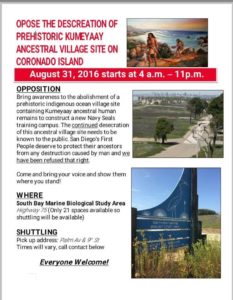
Coronado, Calif. – Protesters in support of the Kumeyaay Indian tribes gathered along California State Highway Route (SR) 75 across from the Naval Base Coronado (NBC) Silver Strand Training Complex – South on Wednesday, August 31, 2016.
Representatives from the Kumeyaay state they are protesting in opposition to the United States Navy (Navy) decision to proceed within the NBC Silver Strand Training Complex – South. In letters to the Navy, the Manzanita Band and the Viejas Tribal Government requested the Navy reduce the footprint of the site from current limits of development established in the Coastal Campus Environmental Impact Statement (EIS) designed to support Naval Special Warfare.
The conflict revolves around the Kumeyaay request that the Navy take action to preserve an area of disturbed land outside the boundaries of the National Register-eligible site (CA-SDI-5454/12270). Throughout the design and construction of the Coastal Campus project the Navy has remained committed to upholding environmental conservation and mitigation requirements established in the Coastal Campus EIS. As part of the proactive compliance posture within the design, an additional 100 foot buffer was provided around all eligible archeological sites and environmentally sensitive areas. The Navy ensures compliance through proactive biological and cultural monitoring of construction activities by independent third party monitors. Names of qualified Native American monitors were requested from the Kumeyaay to work beside the cultural resource monitors during the ground disturbing activities of construction zones near the registered site; however, the Kumeyaay declined.
In Nov. 2014, the California State Historic Preservation Officer (CASHPO), the state governmental function responsible for conducting regulatory review of undertakings within California, concurred with the Navy findings regarding archeological sites in the Coastal Campus project defined Area of Potential Effect. With CASHPO concurrence, the design and construction for the Coastal Campus development avoids impacts to the National Register-eligible archaeological site. CASHPO also concurred in the Navy determination that no other prehistoric “sites” are not eligible, because these represent extensively disturbed or completely transported cultural deposits that are absent the essential integrity required for identifying eligibility.
Following nine months of extensive leadership meetings, subject matter expert information exchange and on-site visits with technical experts designed to enhance the Kumeyaay’s confidence in the Navy’s environmental planning for the Coastal Campus, the Navy finds itself in the unfortunate position where the Tribes will not accept the technical analysis, regulatory compliance posture or the offer to work in cooperation using their own identified Native American Monitors. At the request of the Kumeyaay, a meeting is scheduled to take place on the morning of Friday, Sept. 2, 2016 between tribal leaders and NBC leadership. This meeting was requested and scheduled prior to the protest activity occurring today.
Source: United States Navy
Additional information on the Coastal Campus development project, including design features, compliance with Federal environmental law, and the Final EIS, with a forum for community comments, is available online here.




